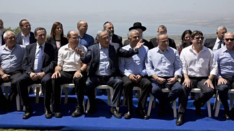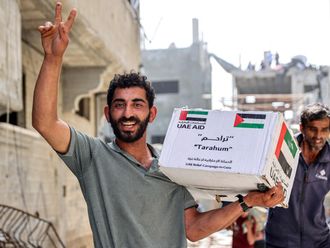
Occupied Jerusalem: Israel’s military said on Friday it was ready to enter a village in Syria where Damascus accused rebels exploded a car killing at least nine people.
The statement was an unusually explicit Israeli pledge to intervene in the war in Syria, where Israeli officials are voicing deeper alarm at the role of Iran and its Lebanese ally Hezbollah, which are fighting alongside the Syrian government.
The Israeli air force says it has struck arms convoys of the Syrian military and Hezbollah nearly 100 times in recent years.
Its most recent strike was on Wednesday according to the Syrian government.
The Quneitra area of Syria, where Hader village is located, is adjacent to the Occupied Golan Heights area that it captured and occupied from Syria in 1967.
Syrian rebel groups launched an attack on Syrian government-held areas in Quneitra on Friday, with the aim of connecting two insurgent-held areas.
The attack included the car bomb in Hader, which Syrian state media attributed to Fatah Al Sham, formerly the Al Qaida-affiliated Al Nusra Front.
Syrian state media accuses Israel of giving various kinds of support to Al Nusra Front.
Hader is populated by members of the Druze, a minority religious sect found in Syria, Israel, the Palestinian Territories and Lebanon.
Syrian state television broadcast footage it said was of residents of Israeli-occupied areas of the Golan Heights attempting to cross the border to assist people in Hader.
In February, Israeli Prime Minister Benjamin Netanyahu asked US President Donald Trump to recognise Israeli control over the Occupied Golan Heights.
Israel annexed the territory in 1981 in a move not recognised internationally.
Israel made a similar request to the Obama administration in 2015, but it was rejected, diplomats said at the time.
While Israel has long coveted sovereignty in the Golan, it is unclear whether the White House would take such a step now, given that it could further complicate the Syrian conflict.
If the United States were to recognise Israel’s claim, it would likely anger Syrian President Bashar Al Assad, who is backed by Russia and Iran in his war with militants and rebel groups.
The Trump administration has talked about working more closely with Russia to end the Syrian conflict. Recognising Israel’s sovereignty in the Golan could undermine those efforts.
It could also spur Iran and its proxies in Syria, particularly the Lebanese militia Hezbollah, to turn more of their focus against Israel, targeting its forces stationed across the Golan Heights.
Israel has warned Hezbollah, with which it fought a six-week war in 2006, against attacking its territory. It has carried out occasional air strikes in the Syrian-controlled portion of the Golan allegedly to target Hezbollah fighters, including units smuggling arms.
Around 25,000 Israeli colonists live in the territory, many of them working in agriculture—there are also about 20,000 Syrian Druze, many of whom have relatives living in just across the valley in Syria.











